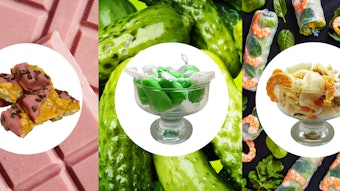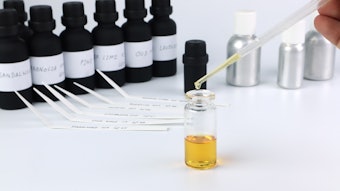The average person probably wouldn’t know it, but there is an abundance of flavor and fragrance history tucked between South Bend and Crumstown, IN, at Shady Lane Farms, now run by third-generation mint farmer Randy Matthys.
“My grandfather bought this farm in the 1930s,” says Matthys, “and there was already an old mint still on the property, so who knows when mint growing started on this piece of land.” In fact, Matthys is in the same general area where mint farming took root in the late 1840s, mainly in the Southern Michigan mucklands (and in fact today you still hear the term “muck farm”) and in Northern Indiana, primarily St. Joseph County. These lands are particularly apt for mint farming, the muck being the end result of plant deposition in standing water in the post-glacial period.
Many American peppermint plants trace their heritage to 18th C. England—specifically, Mitcham in County Surrey (which is also why many of the fields are full of what is called “Mitcham” or “Black Mitcham” peppermint). Peppermint’s long and little-changed pedigree is one of the two things Matthys doesn’t like about the mint business: “Look at that field and you’ll see a plant that hasn’t changed much in thousands of years. And if you look at the corn behind it, how many thousands of different hybrids and versions are there? It seems like we haven’t put a lot of scientific work into getting the best mint crop possible.”
Progress has been made at various universities and by pioneering mint industry chemist and eponymous founder of A.M. Todd in Kalamazoo, MI. (Stay tuned to the next edition of P&Fnow for more on A.M. Todd.) In fact, there is a “Todd Mitcham” variety that has popularity among mint farmers and can be seen growing on Shady Lane acreage. A few universities have performed valuable research through the years. But because of mint’s lack of status as a staple food, Matthys’ comparison is a fair one.
Matthys’ other nettle is the pricing in the industry, which seems to follow neither the classic supply and demand rules nor Adam Smith’s “invisible hand-of-the-market” theory. “You can’t have demand go way up and expect to pay the same thing in any other business,” he states. He also notes that when mint oil prices rise as they did a decade ago, “… you’ll see a lot of new mint growers, or farmers who come into and out of the business based on last year’s pricing. Inevitably, prices recede and the new entrants change to another crop.”
But Shady Lane Farms is otherwise a source of happiness for Matthys, his sons and his father Bud. “There is absolutely nothing like standing out in a mint field on a summer day when it’s 80 degrees and a bit of a breeze with a blue sky overhead,” he says. Indeed, arriving at the farm one is taken with the clean fresh smell of peppermint and spearmint, also grown at Shady Lane. Want a taste? Pull off a leaf and chew.
Currently, Matthys farms about 4,000 acres of land, with 600 dedicated to mint and the rest to corn. Corn’s status as a cash crop has skyrocketed in recent years because of ethanol production, and Matthys lives only five miles from New Energy Corp.’s South Bend plant, which he happily supplies with all of his 3,400 acres of corn.
But mint is the story of Shady Lane Farms. The mint crop is ready to harvest when small flowers appear, which in Northern Indiana usually occurs in August. In the first step a swather cuts the mint plants a few inches above ground level. They will continue to grow thereafter and in some cases Matthys can get a second cutting in one year.
The swather cuts the mint not unlike a giant barber’s clippers with a set of reciprocating teeth. The cut plants move back onto two sets of rollers that drive the cut plants into the middle of the swathed row, where they will sit from one to three days to dry out. A tractor then pulls a harvester and wagons (built by Matthys) over the “hay” to pick up the crop, which is then tossed into the wagons. Once loaded, a truck brings the wagons back to the still. In addition to his own contiguous acreage, Matthys farms a large parcel several miles away where he rotates spearmint, peppermint and corn.
Once the wagons are at the still, they are connected to a source steam line at the bottom, where a series of perforated pipes allow the steam to work its way up through seven to eight tons of chopped mint. A door with a collecting pipe is placed over the rectangular hole near the top of the wagon. This collecting pipe captures the steam infused with oil vapor that is released by the oil glands on the underside of the mint leaves.
The oil/steam mix is piped to a condenser and the water and oil are brought together down to the receiving tanks. Once in the receiving tanks, the oil is separated and crystal-clear raw peppermint oil is drawn off the top of the tanks. At Shady Lane Farms’ still, six wagons can be hooked up to the still at the same time, feeding six receiving tanks.
“For that seven or eight tons of hay, you get about 40 lbs of oil,” notes Matthys. The price of peppermint oil has varied considerably, from as low as $8–10/lb to more than $30/lb during Matthys’ time running the farm, so one begins to appreciate the importance of market pricing. In addition, the heating oil Matthys uses in his boilers to produce steam has gone from below $1/g in 2003 to $3.80/g this year, making profits tougher to produce. His 1,300-ft irrigation system feeds thirsty corn and mint crops at a rate of 1,700 g/min, and adds to the overhead.
After oil production at the receiving tank slows to almost nothing, the wagon is unhooked from the system with a burst of steam. The spent, moist hay is piled on an unused section of the farm and is brought back into the growth cycle as mulch to feed the next crop.
A.M. Todd and The Lebermuth Co. (Mishiwaka, IN) both buy from Shady Lane Farms. “Our families have known each other for generations,” says Irv Brown, chairman of The Lebermuth Company. (Stay tuned to the next edition of P&Fnow for more about The Lebermuth Co. as it celebrates its 100th anniversary.) Indeed, the mint industry still has a family business atmosphere, even though it is shrinking in the Midwest, with the bulk of mint production having moved to the northwest United States. Everyone in the business knows everyone else in the business, and competition is strong but friendly.
Matthys is dedicated to continuing the mint farming effort and tradition; in fact, his sons help plant and harvest the crop. This is good news for A.M. Todd and The Lebermuth Co., whose forecasts rely on an accurate count of acreage and yield—something you can’t get when farmers go into and out of the mint-growing business.
The ultimate product of Shady Lane Farms is further distilled and refined, and there is a chance that you have brushed your teeth or chewed gum courtesy of Randy Matthys and his muck farm in Indiana.










